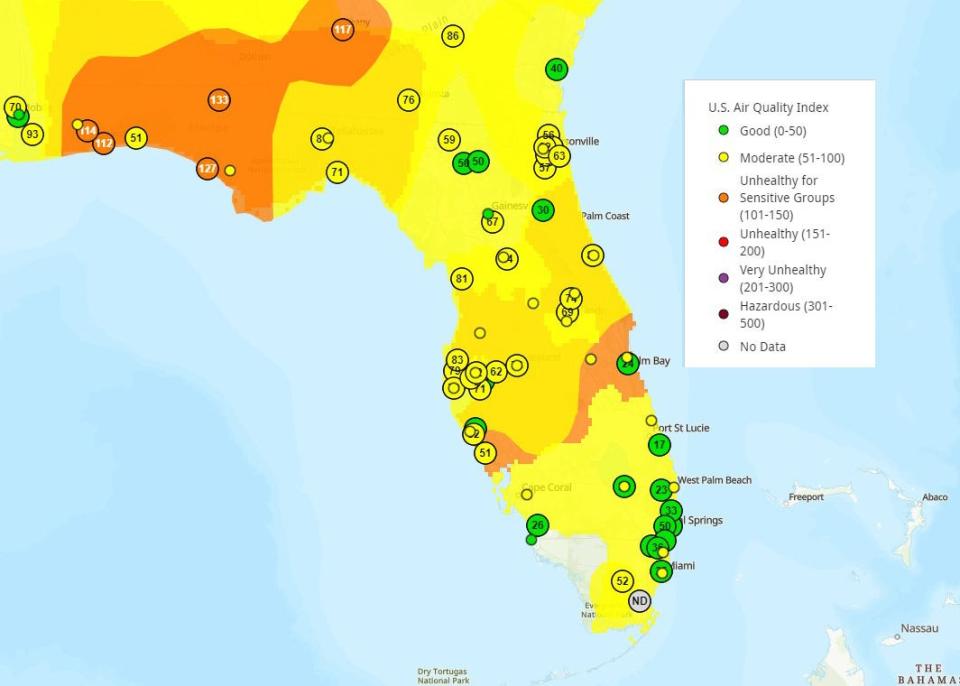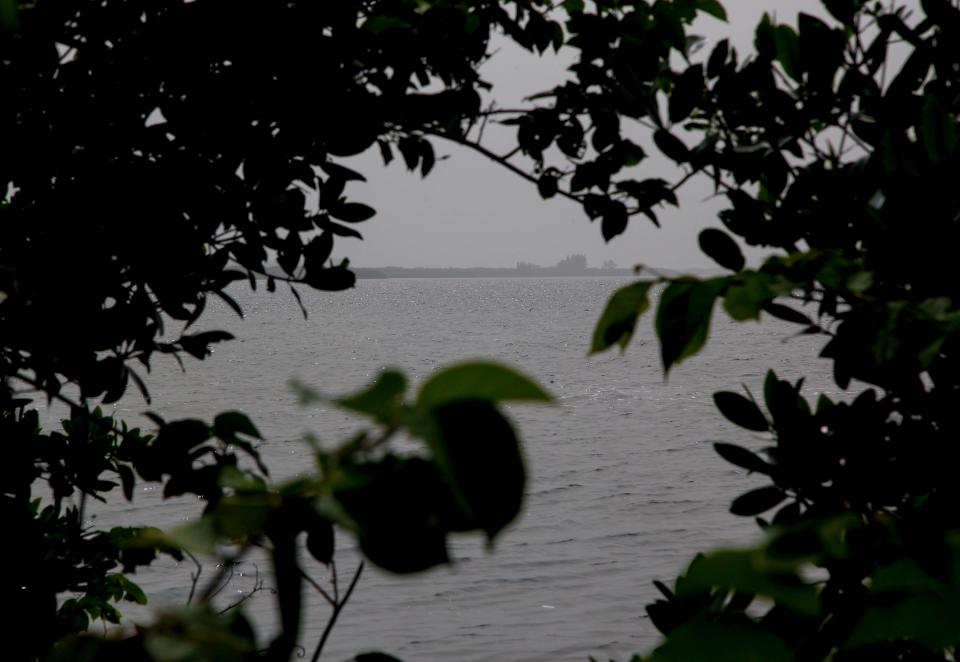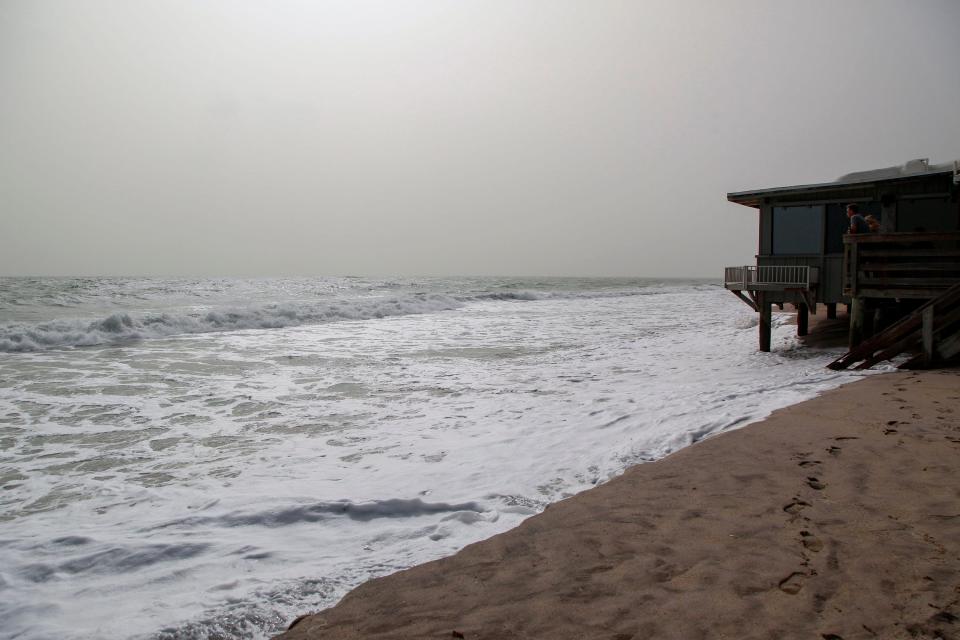Haze in Florida fading Wednesday, here's where air quality is still bad
Is the smoke from the Canadian wildfire that covered Florida skies and made the sun look like the moon finally gone today? Reply hazy.
Smoke from wildfires in Quebec, Canada, south of the Hudson Bay, blanketed Florida Tuesday, causing dangerous and unhealthy air quality conditions across the state, according to the National Weather Service in Melbourne. But the situation was getting better Wednesday.
Air Quality Index (AQI) levels of under 100 are considered moderately safe for humans, according to the Environmental Protection Agency's AirNow.gov site. AQI's in the 150s were measured in Jacksonville and across east central Florida in the morning Tuesday, and by the afternoon AQIs in the 160s were measured in Volusia and Palm Beach counties. An AQI over 150 is considered unhealthy even for people without lung or heart problems.

As of Wednesday morning, only the western part of the Panhandle and a small strip across the state from Brevard-Palm Beach counties over to Manatee County was showing poor air quality, with an AQI of 133 in Bonifay, 127 in Panama City Beach.
Here's what you need to know.
Smoke gets in your eyes: Canadian wildfire smoke reaches Florida creating an 'unhealthy' air quality
Why was it so hazy in Florida?
Smoky skies had us all talking today! Here was the path that the Canadian wildfire smoke took on its way to Florida. The red circle indicates where milky haze/smoke appeared each day on satellite since late Sept. on its path ultimately to us. #FLwx @CIRA_CSU pic.twitter.com/qmisP2SMdp
— NWS Melbourne (@NWSMelbourne) October 3, 2023
Smoke from a wildfire in Canada worked its way down the U.S. coast, skirted around a high-pressure system, and curled around to blow across northeast and east-central Florida Monday evening.
Where is the smoke from Canadian wildfires going?
You can track smoke from wildfires here.
Is the haze dangerous? What is the air quality in Florida?
Smoke haze all the way from the Canadian wildfires in Northwest Florida. #FLwx #wxtwitter @JimCantore @spann @rzweather @RyanMichaelsWX @NWSMobile @StormHour @ThePhotoHour pic.twitter.com/XYnf7sA9wF
— Jenna Loves The Sky (@JenLovesTheSky) July 19, 2023
The Environmental Protection Agency's AirNow air quality forecast shows that for some areas across the western Panhandle and lower central Florida, air quality may be dangerous for anyone sensitive to particle pollution such as people with heart or lung disease, older adults, children and teens. Anyone in those groups should stay inside as much as possible today.

“It's going to start improving later (Tuesday),” said Melissa Watson, a meteorologist with the National Weather Service. “We can’t say it will be perfectly clear, but it will definitely be less hazy.”
Watson said people with difficulties breathing because of conditions like asthma should take precautions or limit time outside, keep inhalers on hand and talk with their doctors about exposure to the particulates in the smoke.
“Winds will definitely play a factor,” she said.

How long will it stay hazy in Florida?
Just before sunset tonight from #Tallahassee near the Ochlockonee River.
The #crepuscular rays were intense thanks to the haze in the air this evening! #LoveFL #FLwx #Florida #Tally #Air2s #DronePhoto #StormHour @spann pic.twitter.com/jJcnSGcnoB— Wright Dobbs (@WrightDobbs) March 7, 2023
The haze may be visible through Wednesday but the danger should be reduced by Wednesday morning, AirNow predicts, with a moderate air quality over the Panhandle and good everywhere else in the state.
To monitor the air quality in your specific area, you can type in your ZIP code into the AirNow.gov website.
Is inhaling wildfire smoke dangerous?
Inhaling smoke can be dangerous because it contains a mixture of hazardous gases and solid particles smaller than a human hair, called particulate matter (the EPA calls it PM 2.5) which can easily enter your lungs and bloodstream and cause damage to other organs.
Fortunately, as smoke moves downwind it generally becomes more diluted and widespread but less dangerous, according to Susan Stone, a senior environmental health scientist in EPA’s Office of Air Quality Planning & Standards.
How can I tell if smoke or poor air quality is affecting me?
Even healthy people may experience irritation of the eyes, nose and throat, coughing, chest tightness and shortness of breath, according to AirNow. The symptoms should fade once you remove yourself from the area or the air quality improves.
People with lung diseases, including asthma and COPD: You may not be able to breathe as deeply or as strongly as usual and may experience chest discomfort, wheezing, shortness of breath, and unusual fatigue.
People with heart or vascular disease: Chest discomfort (uncomfortable pressure, fullness, squeezing, or pain in the center of the chest that lasts more than a few minutes or goes away and comes back), discomfort in other areas of the upper body (pain or discomfort in one or both arms, the back, neck, jaw or stomach), shortness of breath, or other signs may include breaking out in a cold sweat, nausea or light-headedness. Seek emergency medical treatment if you experience these symptoms. But particle exposure can cause serious problems, including worsening of your disease, in a short period of time, AirNow says. Do not assume you\'re safe just because you don\'t have symptoms.
How can I protect myself from bad air quality?
Here are some tips from AirNow.gov for people with heart or lung disease, older adults, children and teens to avoid lung irritation and health complications due to increased air pollution:
Stay indoors in an area with filtered air. Avoid strenuous outdoor activities that make you breathe faster or more deeply. Consider moving physical activities indoors or rescheduling them.
Protect the air in your home. Keep doors and windows shut and make sure your air conditioner has a good, fresh filter. If your air conditioner has a fresh air setting, make sure the fresh-air intake is closed.
Keep an eye on symptoms. Higher levels of smoke in some areas can make breathing more difficult. If you are experiencing symptoms, contact your healthcare provider.
Take precautions for kids. Extra precautions should be taken for children and teens, who are more susceptible to smoke. Their lungs are still developing, and they breathe in more air (and consequently more pollution) for their size than adults.
Contributors: Ridah Syed, Laura Schulte, Milwaukee Journal Sentinel; Corey Arwood, TCPalm
This article originally appeared on The Daytona Beach News-Journal: Smoke from Canada wildfires moves away from Florida, still affects air

